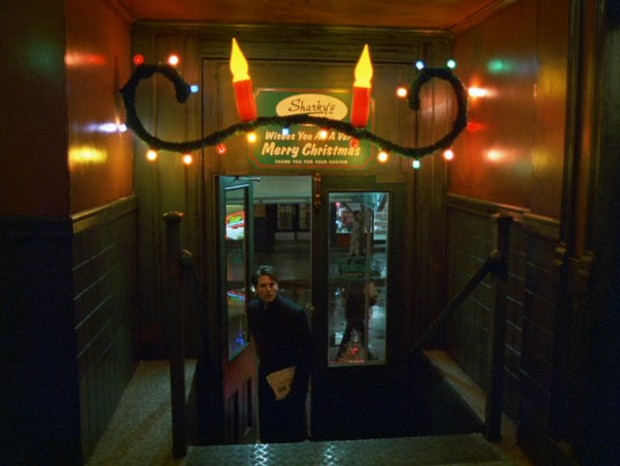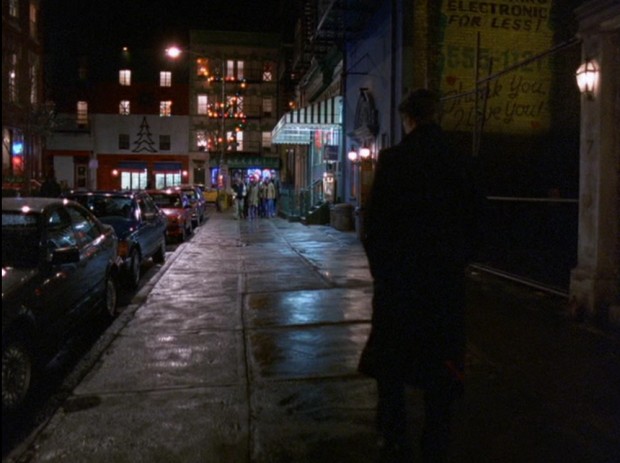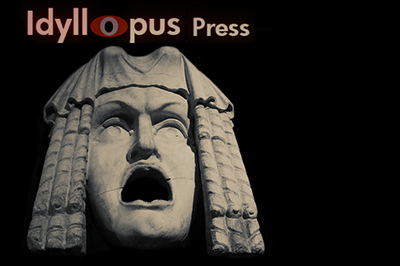Breaking Circular Dreams
Examining Eyes Wide Shut in respect of the films Open Your Eyes, Vanilla Sky and The Devil's Advocate
Go to TOC for this film ( (which has also a statement on purpose and manner of analysis and a disclaimer as to caveat emptor and my knowing anything authoritatively, which I do not, but I do try to not know earnestly, with some discretion, and considerable thought).
Back in May of 2019 a reader, Johnny Maroney, wrote and alerted me to a scene in The Devil's Advocate that he felt may have influenced the opening dressing room scene in Eyes Wide Shut of Alice. We discussed it, and I soon thereafter wrote a page on it that I never posted as it felt first draft rough. Only now am I getting back around to tackling it.
The Devil's Advocate is a 1997 film, directed by Taylor Hackford, in which Kevin Lomax (Keanu Reeves), an aggressive lawyer with no scruples, after successfully defending a math teacher against the molestation claims made against him by a student, is enticed from his Florida home to an elite law firm in New York by its Mephistophelean head named Milton (Al Pacino). Kevin begins to draw away from his wife, Mary Ann (Charlize Theron), as soon as he lays eyes on a fellow lawyer at the firm, Christabella. At film's end, after his wife has been driven mad and committed suicide, he learns Christabella is his half-sister, and that they are both children of the supposed devil (Milton) who desires they should have a child who Milton says will be the antichrist.
The shot in question, from The Devil's Advocate is Christabella's temptation of Kevin, who ultimately denies her and Milton, shooting himself.

Christabella tempts Kevin in The Devil's Advocate
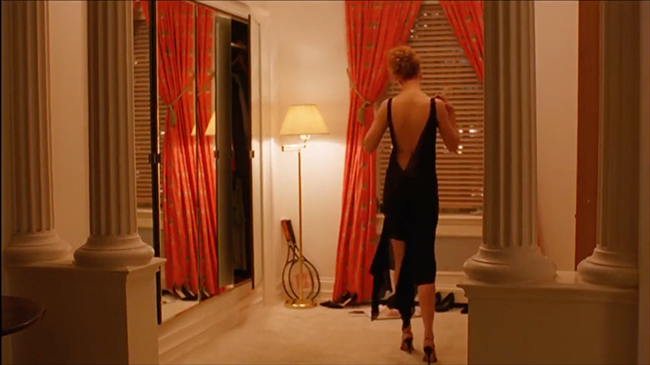
Alice undressing in the opening of Eyes Wide Shut
At first glance, my reaction was that there was indeed a resemblance, but how many movies are there in which we have rear shots of a woman disrobing? To be able to make a judgment I needed to watch the film, which I had previously passed over as the trailer looked cheesy. Which means, though the film is, indeed, ridiculously cheesy and overwrought, I'd not seen Pacino's astute dark comedy performance as the devil as a humanist, the advocate of the fallen Adam and Eve.
The back shot of Christabella perhaps needs to be looked at in context of two other dramatic back shots in that film, which seem to build up to this last one and supplement meaning. The first occurs when Kevin has been tempted to do a night out on the town with Milton, Christabella and others, he leaving his wife at home who is at the beginning of her mental health crisis. He is speaking with her on the phone from a restaurant with Flamenco dancers, and he briefly sees the back of a dancer in red as she gazes at herself in a mirror. The idea communicated is that of temptation, and the purpose of the evening is all about temptation further driving him away from his wife, but the dancer's reflective image in the bevel of the mirror is distorted in a way that will remind of several shots in the film when individuals are briefly transformed to have "demonic" features.
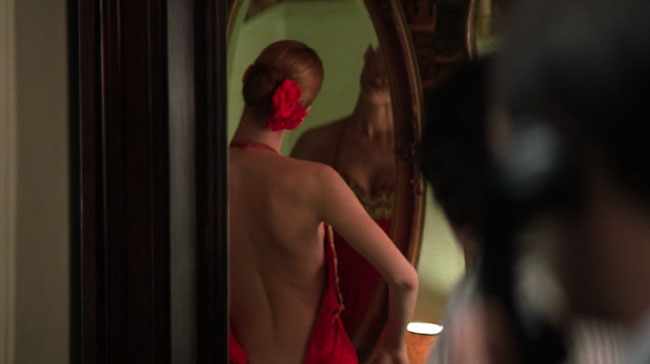
Kevin glimpses the back of the Flamenco dancer
The second back shot occurs at a church. Kevin has successfully defended Alex Cullen, a billionaire who has been accused of murdering his wife, stepson, and maid. It's been made obvious to the viewer that Alex was indeed the murderer, and the "why" becomes apparent to Kevin as he sits in the church and views Alex run his hand up the back of his stepdaughter, Alessandra. The gesture is sensual, the stepdaughter frozen, helplessly enduring. Briefly, Kevin sees Alex's face morph into the face of the child molestor he'd successfully defended at the film's beginning, and he realizes that Alex's possessive devotion of his stepdaughter is that of a pedophile, and that the murders were committed so that he might have possession of his stepdaughter.
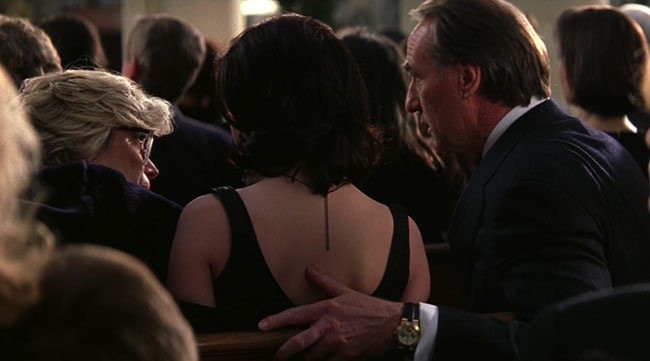
Cullen's hand on his stepdaughter's back
Finally, we have the scene with Christabella, in which Kevin is tempted to father the antichrist with his half-sister, whose name means Beautiful Christ/Anointed One.
Christabella beckons Kevin to look at her, really look at her. The disrobing is not the revelation, her naked body is not what Kevin is being called upon to see. When she turns and spreads her arms, she drops her head to the side and down. She has assumed the posture of Christ on the cross. And she asks, "Who am I?" The answer is not stated in the film. The actress, rather than voluptuous, is slender enough that the audience, seeing her ribcage, is left to make an association with Christ on the cross. I imagine that The Devil's Advocate intends to connect her with the idea of Babylon, a false queen who principally stands for something that is deceptive, as in false "idols", and her posture is intended to be a mocking of the biblically held redemptive death of Christ, but there are other layers to be considered. One of these is that the film has made child sexual abuse a focus, and though Christabella is an adult, we should consider how she has herself been abused by Milton, her father. She becomes also a victim when looked at from this perspective.
"Look at me, just look at me," Christabella tells Kevin.

"She is really stunning," Milton observes.

Christabella asks Kevin, "Who am I?"
The scene in question, wherein Christabella appears as Christ, comes flying in a bit under the radar because what has been rather hammy dramatic tragedy becomes pretty funny with Milton reproaching heaven concerning free will. As far as Milton (the devil) is concerned, he is an advocate for humankind and the concept of free will.
If Kubrick does refer to The Devil's Advocate, then there is a "why", but what exactly is that "why". A back may still simply be a back and the two films may only have a coincidental seeming connection that isn't actually there. When I consider "might Kubrick have referenced this" I like to see if there are several other distinct similarities or acknowledgments, and when I watched the film there did appear to be others. I have included dialogue, in bold, in this particular scene with Christabella in The Devil's Advocate because it also appears in Eyes Wide Shut, which is why I lean toward believing that Kubrick does intentionally refer to Christabella in his portrayal of Alice undressing at the film's beginning.
In the bathroom, following the opening dressing room scenes in Eyes Wide Shut, Alice asks Bill how she looks, he says she looks perfect without even glancing at her, he is caught up in himself, looking in the mirror, and she complains about this. That could take us back to Christbelle saying "look at me" and Milton telling Kevin that he lost his wife, who commits suicide in the movie, due his vanity, his self-love, the fact he was so involved with himself that he was willing to sacrifice her with his focusing all his energies on his career despite his awareness she is mentally fragmenting. The point is that Alice is asking for herself to be really seen, and the director as well is asking that the audience actually examine and see what is occurring.
ALICE: How do I look?
BILL (facing the medicine cabinet mirror, without turning, for all we know he's speaking about his own appearance in the mirror): Perfect.
ALICE (rises from the toilet, wipes, pulls up her underwear): Is my hair okay?
BILL (adjusts bow-tie and does the last two buttons on his shirt): It's great.
ALICE (flushing the toilet): You're not even looking at it.
BILL (facing her): It's beautiful. (He kisses her neck as the camera pulls in a little tighter.) You always look beautiful.
"How do I look?...You're not even looking...," Alice chastizes Bill.

Alice and Bill before Victor's party
Alice and Bill then go Victor's party, for which they are running late. At the party, Victor tells Alice she is stunning, and when he says he doesn't say that to all the women, Illona laughs and says that he does. We may be reminded of Milton saying that Christabella is "stunning".
VICTOR (to Bill): Merry Christmas! (To Alice.) Merry Christmas!
ILLONA: Thank you for coming.
VICTOR: How good to see both of you. (Kisses Alice on both cheeks, then as his wife kisses Bill...) Thanks so much for coming.
ALICE: We wouldn't have missed it for the world.
BILL (to Illona): It's good to see you.
VICTOR: Alice, look at you! God, you're absolutely stunning!
ALICE: Ahhh.
VICTOR: And I don't say that to all the women, do I, Illona?
ILLONA (laughing): Oh, yes, he does.
ALICE: Oh, he does?
"Alice Look at you! God, you're absolutely stunning," Victor tells Alice.
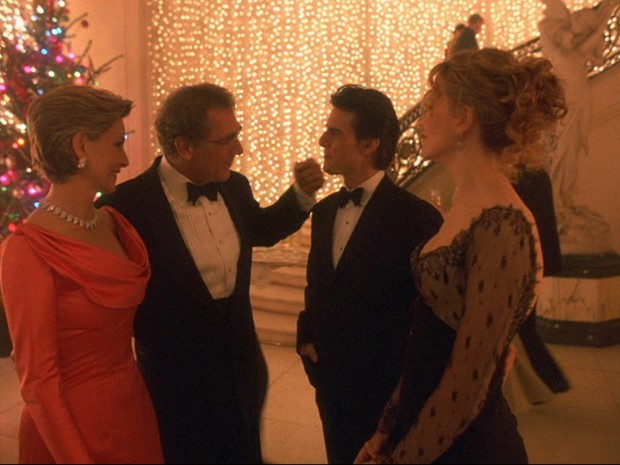
Alice and Bill at Victor's party
Both films are concerned with a male protagonist who is attracted to the upper echelon, and in both films a gap created between the protagonist and their marriage partner is crucial, and is most critically furthered via a party. In the book, Traumnovelle, upon which Eyes Wide Shut was based, there was nothing really equivalent to Victor's party, at which Bill and Alice separate for her to go the bathroom, and though Bill promises to reconnect with Alice at the bar he never shows up. Instead, after meeting with a former classmate, the piano player who eventually leads him to the orgy at Somerton, he falls in with two flirtatious women who promise to take him to where the rainbow ends, then is called up to Victor's bathroom to attend to Mandy's overdose. This leaves Alice alone, amongst people she doesn't know, feeling abandoned. She is a vulnerable woman, insecure as she has lost her job, uncertain as to her identity as without a career she is now only a wife and mother, and now her husband has disappeared at a party she's attending only because of Bill's job, where she is only Bill's wife. A very serious flirtation develops between her and another partier named Sandor, but when he demands to see her again she reproves him by displaying her wedding ring and reminding him she's married. A little complaint also seems to be heard in her voice, that her marriage defines her, but it is also, at this moment, a safety net. Later, when she asks Bill where he was, he lies, Victor having asked him to keep Mandy's overdose between the two of them. Bill allows his relationship with Victor to take precedence over Alice, just as Kevin allows his working relationship with Milton to come between him and his wife.
Though there is no such party in Traumnovelle, there is in The Devil's Advocate. Just as Bill and Alice were running late to Victor's party, so too do we have Kevin and Mary Ann running late to a party of Milton's. Just as Alice knows no one at Victor's party, Mary Ann doesn't know anyone at Milton's party, and before they arrive she has Kevin promise to not leave her alone. But he does leave her alone, because of business, and due his falling into a flirtation with Christabella. Milton takes advantage of this separation to flirt with Mary Ann, working on her vanity while paying her the attention she needs when she feels shut out. At one point, he asks her to pull her hair back, saying he would do it himself but everyone would think they were fucking.
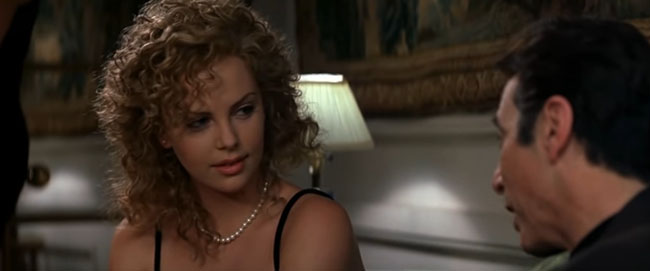
Mary Ann with Milton at his party, abandoned by Kevin
When Mary Ann does pull back her hair, Milton tells her she needs to cut it, getting rid of her "perm", and change the color to her natural brunette. Her hair is fine as it is, he says, but it's not her. The thing about Milton, as the seducer, is he is someone who listens and looks. He makes Mary Ann feel as though she is being seen, as if this man does know her.

Mary Ann pulls her hair up for Milton
I'm reminded of Fellini's Juliette of the Spirits, in which Giulietta is being ignored by her husband, Giorgio, who we later learn is having an affair. A sublime friend of his visits and tempts Guilietta with wholly devoting his attention to her so that she feels as though she is really seen by him. He offers her sangria. It's an entirely different film, to be certain, but there's a lot going on there in the offering of this drink to Guilietta, considering some childhood perceptions impressed upon her by the church she's having to recognize and address, as well as patriarchal attitudes that alienate her from her true self with the confining definition of her as Giorgio's wife.
Returning to The Devil's Advocate, Mary Ann cuts her hair and goes from blond to brunette, which is the beginning of her collapse. She believed she knew who she was. Milton, telling her that her appearance wasn't really "her", has cut her off from her sense of identity and supplanted it with another one. Though she has returned, seemingly, to an appearance that is more "naturally" her own, having done this at Milton's urging, she becomes dissociated from, at least, who she has chosen to be. More than this, she has changed herself at Milton's urging, his attentions being overtly sexual. He had said, asking her to cut her hair, that the neck represented the battleground between the mind and body. Milton has, one could say, taken possession of her body through his desire, and her conflicted response to it. One day she appears covered with scratches and states Milton had sexually assaulted her. Her mental state having profoundly deteriorated, she's not believed, it's thought she has harmed herself--but later Milton confirms he'd had sex with her. When Mary Ann commits suicide, she slices her jugular, which returns us to Milton's remark on the neck representing the battleground between the mind and the body.
It's to be noted that Mary Anne's brunette hair cut somewhat resembles that of Alex Cullen's stepdaughter's.
Alice, though she appears to be questioning her identity through having lost her job managing an art gallery, left at home all day, doesn't have an acute rupture with her identity. She may be sometimes insecure but she fundamentally knows who she is. Instead it is Bill who experiences a crisis when he learns Alice is different from what he imagined her to be. She is not only his wife, and the mother of his child. She is more than this. Her secret thoughts and desires are sometimes radically different from what he could have imagined. And his doubts over Alice, over what she is at heart, send him reeling with jealousy over her revelation she was once so attracted to another man she would have left both him and their daughter..
I will mention here that Arthur Schnitzler, the author of Traumnovelle, was a womanizer, and this book may partly address frustrations over and an attempt to reconcile feelings concerning his ex-wife. He was an individual who slept with many women, keeping a diary of every encounter. When he was about 40 he married a 21-year-old actress and singer named Olga Gussmann, but continued his affairs with other women. Their marriage was turbulent. Olga felt that she had sacrificed her career as a wife and mother. After she revealed to Alma Mahler that, feeling neglected, she'd had an affair with a pianist, William Gross, who was closer to her age, everyone soon learned about it and she and Arthur divorced in 1921. Schnitzler wrote that, for a year, he would wake crying with anger. He could be sexual outside his marriage, but when Olga had an affair he was enraged.

Mary Ann changes herself for Milton and begins to mentally collapse
Based on not just the back shot of Christabella, but on Christabella demanding Kevin look at her, Alice reproaching Bill for not really looking at her, the big party for which they are late, the hair, Victor telling Alice she is stunning, and Bill and Alice being separated at the party (which leaves her vulnerable to Sandor) just as Kevin and Mary Ann are separated at the party, I think there's a reasonably fair possibility Kubrick was referring to The Devil's Advocate and that this isn't a case of a few random similarities.
But there's more--and that concerns how The Devil's Advocate ends.
The entrance point for Kevin's temptation by Milton is during the opening trial where he successfully defends the math teacher who is a pedophile. Things aren't looking so good with the trial when Kevin takes a break. The girl who has accused the math teacher has been a formidable witness and it looks like they may lose. In the restroom, before washing his hands he removes his wedding ring. A sound effect alerts us to a seeming change in atmosphere, and a reporter speaks to him from a urinal saying that no one can win them all. Galled, determined to win what seems a lost case, Kevin returns to the court room and decimates the witness of the child, attacking her credibility. One could look at this moment in the bathroom, as Kevin stands before the mirror, as the opening for temptation through his removal of the ring that signifies his marriage vows--but I also think of how Christabella is later associated with Christ on the cross, and am reminded of Pontius Pilate washing his hands of Christ's death, he takes no responsibility, whereas Kevin is always advocating for people who are guilty but takes no responsibility when they are freed and continue to harm others.
Toward the film's end, when Milton reveals to Kevin that he is his father, and is "satan", he repeats to Kevin what the individual had said to him in the courthouse bathroom, so we know this was the initial crisis where Kevin had a choice and succumbed to temptation. He had become undeniably aware that the math teacher was certainly guilty, and that moment was when he decided to, never-the-less, defend him for the sake of winning.
At the film's end, Kevin exercising his free will and rejecting Milton's proposal to have sex with his half-sister in order to produce an anti-Christ, shoots himself. As he dies, so does Milton melt away in flames, his face transforming into Kevin's.
At which point we are returned to the courthouse bathroom again, as toward the beginning of the film, Kevin's ring removed, he washing his hands, the reporter calling to him and saying you can't win them all. So, it seems that the film was but a "dream" of sorts, an oracle of what might happen, or did Kevin purchase redemption in his exercising free will, returning him to a point which was not one of no return. When he shoots himself, he destroys the world that became as the result of wrong action, and is able to effect an alternative future. Returning to the courtroom, this time Kevin steps down from representing his pedophile client, asking to be replaced. This means he will not receive the offer from Milton to go to New York, based on his successfully defending the pedophile. He and Mary Ann will not be going to New York. This means that she is potentially saved. She will not go crazy and kill herself.
All a kind of dream? A fantasy? As in Eyes Wide Shut, what was real and what was not? At one point in the film, Kevin, his life falling to pieces around him, in the early morning light stands at the intersection of 3rd Avenue and E. 57th, near Sutton Theater at 205 E. 57th Street and the streets are empty. There's no one to be seen. This isn't right at all and the viewer knows it's not right. Perhaps so too does Kevin. Certainly, the viewer should be alerted to this being an impossible scene and that something is not right. The film is allegory.

An empty E. 57th Street.
This circularity can also be found in Kubrick's films. Fear and Desire begins and ends with the same shot of the forest where an uncanny adventure takes place in which the soldiers kill their enemy doubles. Killer's Kiss begins and ends with railroad station, the story told in flashback. In A Clockwork Orange, the reformed Alex stumbles onto, one after another, individuals he'd formerly harmed, the tables now turned against him. The Shining is all circularity hinging on Jack's sense of deja vu, as if he knew The Overlook and what was around every corner.
The cirularity most similar to Eyes Wide Shut is in Lolita, which begins and ends at the mansion where has been living Quilty, another abuser of Lolita's who has repeatedly insinuated to Humbert his own abuse of the girl. At the film's beginning, Humbert enters the mansion and ultimately kills Quilty. The film closes again with Humbert entering the mansion, looking for Quilty. But it is a different take this time, not the same as the one at the film's beginning. if the takes are slightly different, what does that mean for the outcome of the story as it circles around and begins again. Will it be the same? Kubrick rather duplicates this in Eyes Wide Shut, but it's as if he has taken that circularity and repositioned it so rather than the end of the film referring back to the beginning, we observe the circulairty at the very beginning.
Kubrick opens Eyes Wide Shut with Alice undressing and never explains when this is, the timing of the scene conflicting with the following one of Bill in the dressing room, for everything is different in the dressing room when we see Bill in it. If Kubrick is referring to The Devil's Advocate with this rear shot of Alice, he is doing so in his very first shot after the credits, which gives it some weighty significance, and he does so in an interesting way. Alice, in that first shot, is completely removed from the rest of the movie. We don't know when this event occurs, for as I've stated when we next we see the dressing room everything is changed, the lamp is removed, a rug is on the floor (which will later appear in the dressing room at the Rainbow), Bill's shoes are all over instead of Alice's, and even the view out the window is different.

Alice undressing in the opening of Eyes Wide Shut

The shot that separates the two dressing room scenes in Eyes Wide Shut

Bill in the opening of Eyes Wide Shut
Shot 5, after the initial credits, is Alice undressing. Shot 6 is the title card, Eyes Wide Shut. Shot 7 shows a man seated on a bench across from the apartment building where Bill and Alice live. Shot 8 then shows Bill in the dressing room and it is dark, the light off, and it is different, and we realize that the opening shot of Alice is, in a sense, an alternative space, especially when we consider that the view outside the window is different. Here is Kubrick's circularity, imperfect as in Lolita and The Shining, signaling possibly different outcomes, and it's not at the beginning and end of the film but packed into the beginning in these nearly adjacent shots. One could almost wonder what story has already transpired between those shots, what film, and now we have returned for a different version.
We will return to that same scene of the man on the bench in shot 437, 430 shots later in the film, after Bill's second visit to Somerton wherein he's handed the note that tells him to cease his inquiries, as he returns home to find Alice and Helena at the dining table doing math exercises. Shot 437 is almost identical to shot 7, only a few moments further along. In shot 7, the cut away to shot 8 is made when a man in a white jacket is crossing the street to the right and a taxi approaching, just as it reaches the first crosswalk. Shot 437 begins with that taxi now moving past that crosswalk and the man in the white jacket finishing crossing the street. Kubrick could have used the same clip for 437 as for 7. Instead, the action in shot 437, supposedly a couple days later from shot 7, continues the action from shot 7 rather than repeating it, or having a take that is noticeably different from shot 7. By shot 437 continuing the action in shot 7, we have been returned, for some reason, to the beginning of the film, to the point that separates the two versions of the dressing room, the one with Alice, and the very different one with Bill, in which he is looking out the window and one could imagine he is even looking down at the man on the bench. As I've previously pointed out, this shot of Bill also ties us to the Rainbow costume shop, as the dressing room now has a rug that will be seen in the dressing room of the shop.
In the scene of Alice teaching their daughter math, Bill looks at Alice and remembers a dream she'd told him about in which she'd had sex with hundreds and hundreds of men, and she looks back at him with a gaze that could be interpreted in any number of ways. It could be a look of no import, it could be an intimate gaze and smile, it could be a gaze that seems to have a secret behind it, as if she is knowledgable of his bewilderment and a Mephistophelian design guiding him through this adventure. But Alice is also certainly utterly bewildered by events that take place. We observe her anguish when Bill tells her of his adventure. She is a spouse that he has taken for granted and is more than she seemed to him, but she is not a Mephistopheles per se. In The Devil's Advocate, Milton ended up having both the face of Kevin and the reporter in the bathroom. Milton was not a person so much as a process of waking to oneself, of becoming conscious. The man on the bench was actually in the book, Traumnovelle, and represented much the same, for in the book he was a homeless man who the protagonist encounters, who he thinks he should help by giving him some money, which sets off its own process of self-reflection and fear as the protagonist imagines everything that could possibly happen if he assists the man, how it could change his life, how he could possibly contract a disease from him that would eventually kill him. He is not just a homeless man. He represents worlds of possible outcomes, cause and effect, and the protagonist, not giving him any money, is then conflicted throughout with judging himself, balancing his excuses against his actions.
At the end, Bill and Alice are left to muse on what is real and what is only a dream, and that complete truth is not had in only one or the other.
The audience is left to wonder what was real and true.
Just as with The Devil's Advocate.
Now I'm going to move from The Devil's Advocate, which was released in October of 1997 in the U.S., to looking at another 1997 film, Alejandro Amenabar's, Open Your Eyes, released December 1997 but not until April 1999 in the U.S., which was remade into Cameron Crowe's Vanilla Sky in 2001.
In the 1960s and 1970s, with the fear of a nuclear apocalypse, more than one film had surviving characters roaming empty cities. The empty city of The Devil's Advocate was instead a signal to both Kevin and the audience that this was an experience that couldn't really be happening. We have the same in Open Your Eyes. A man, Cesar, wakes to an alarm that tells him to open his eyes. He gets up, gets dressed, and only when he goes out into the streets of the city does he realize something is wrong as the streets are empty. He is by himself.
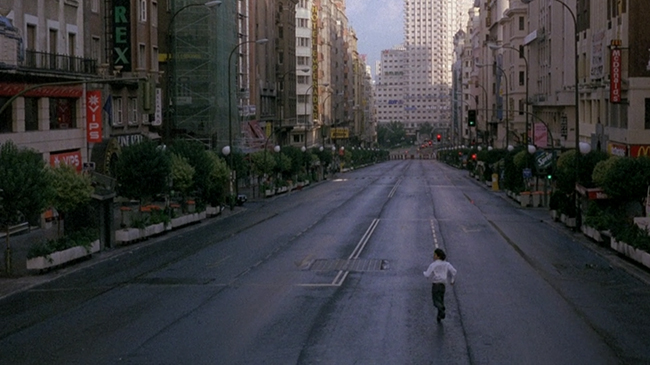
Waking to the empty street in Open Your Eyes
He wakes up again. What he'd experienced, it seems, was just a nightmare. He goes out again and this time the streets are full of people. He meets up with a friend with whom he is going to play racquet ball. But again, there is something odd. As he drives down the street he sees a woman in a mask, dressed as a mime, and his attention is drawn to her. Later, he meets her and her name is Sophia (wisdom).

The mime in Open Your Eyes
She's a mime artist--a mimic, the voiceless art of imitation--who functions as both premonition and the deja vu sense of experience repeating itself. The plot of the film is that this is a man who met a woman named Sophia and fell in love with her. He was a womanizer, and involved with another woman, Nuria, who had believed they were in love. Instead, he describes her to others as stalking him, following him. The night he meets Sophia, he goes to her apartment and stays with her until dawn. They do not have sex. Instead, they talk. He falls in love. When he leaves Sophia's, Nuria is waiting for him outside. She invites him into her car and he obliges because she won't desist. She confronts him with how he doesn't even know her phone number or where she lives. She tells him that happiness for her is being with him. What is happiness for him? After asking if he believes in god, she crashes the car, committing suicide. He survives but his face is disfigured.

The mask Cesar will wear over his disfigured face in Open Your Eyes
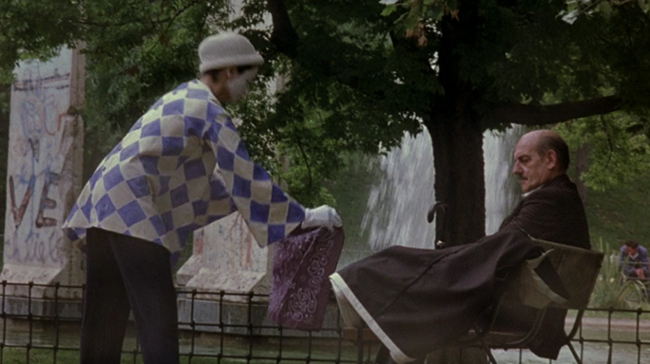
Another scene of Sophia, the mime, in Open Your Eyes
For a while Cesar avoids others, unwilling to show his face, but eventually he finds Sophia in the park and they arrange to see each other again. Unable to accept his appearance, he's given a mask that is a last resort for those who reject themselves, and has a failed meeting with Sophia at a nightclub. The morning after, he wakes on the sidewalk, where he'd passed out, to find Sophia there, and they become a couple. New surgical techniques lead to his face being perfectly repaired, immediately after which Sophia seems mysteriously replaced by Nuria, the woman who committed suicide. Though he is told over and over again that the woman who appears to be Nuria is Sophia, he kills her, for which reason he is then revealed as being actually in prison and the action of the film thus far are flashbacks through his meetings with a psychiatrist. At the film's end, we learn that he had never gotten back together with Sophia, that he hadn't had surgery, that he had instead committed suicide and arranged for himself to be preserved cryogenically. He is not in prison at all. He is instead frozen and all that he has been experiencing is a virtual dream, the splice between real life and the dream positioned on the night he passed out on the sidewalk, so he's had no memory of what subsequently happened. The dream, however, has gone out of control and, in essence, has been trying to wake him to the fact none of this is real, just shadows of a past reality that were meshed with things that never did happen. He makes the decision to wake, which means that he must overcome his vertigo and dive off a high building. All goes black at the end of his fall, and then we hear, "Open your eyes." The film is science fiction, but is very similar to Kubrick's circularities, which in 2001 are revealed, through the association with Nietzsche's "Thus Spake Zarathustra", as exploring a version of his Eternal Return, in which eternity is our repeating our lives over and over and over again and perhaps becoming conscious of it. Only with Kubrick's circularities, change is possible. Still, as with Nietzsche's projection as to the horror of this, in Eyes Wide Shut, via one of the newspaper articles in the "Lucky to Be Alive" paper that Bill reads, Kubrick also refers to these circularities as mental violence.
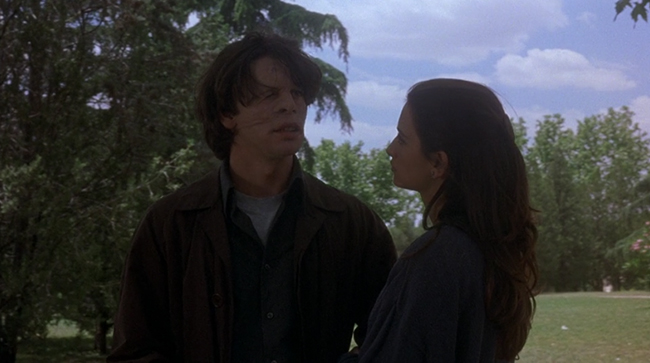
"Do you ever feel you've lived something before?...I've been here before."
In Open Your Eyes, the park, with its benches, is revisited several times in the film, and associated with having the feeling of things repeating. In one scene, the protagonist states he has dreamed of meeting Sophia again, and that his dream was almost exactly like the reality of their meeting again with a small change. In a later scene, in the park, he asks Sophia, "Do you ever feel you've lived something before?...I've been here before."
In Vanilla Sky, the 2001 remake of Open Your Eyes, Tom Cruise, who played Bill in Eyes Wide Shut wakes to the alarm calling to him, "Open your eyes". On the television plays the film Sabrina.

Waking to the film "Sabrina" in Vanilla Sky
When he drives out onto West Central Park Avenue and sees it is empty is when he realizes something is wrong, and begins to panic. He wakes again, the movie Sabrina playing, and this time his lover rests beside him, the woman who will later commit suicide then return as Sophia.
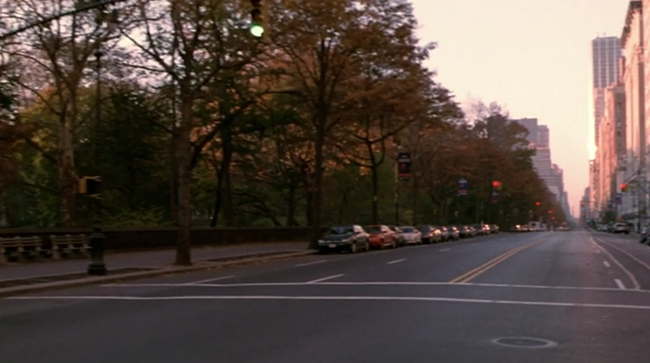
An empty West Central Park Avenue in Vanilla Sky
Having glanced at Open Your Eyes and Vanilla Sky, let's examine again the opening of Eyes Wide Shut again. Shot 5 is Alice undressing in the dressing room. Shot 6 is the title "Eyes Wide Shut". Shot 7 is the man on the bench in front of the apartment building. Shot 8 is Bill (Tom Cruise) at the window in the greatly changed dressing room, looking down perhaps toward the bench. Though the bench does appear in the book, Traumnoveille, because it does figure so strongly in Open Your Eyes, associated with deja vu and the mime, I think we need to consider the influence of this film on Eyes Wide Shut--or should I instead say that with Kubrick's referencing Open Your Eyes, he is commenting on certain themes in his own work. The bench, as noted, appears again in shot 437, that scene being a continuation of shot 7. "Do you ever feel you've lived something before?...I've been here before." This is enacted with these two scenes and remarks on the two opening, similar but very different scenes of the dressing room.
With Tom Cruise in Vanilla Sky, I feel that a nod of recognition is given to Eyes Wide Shut and its referring to Open Your Eyes. The protagonist, Cesar now a man named David Aames, lives just a block from the San Remo where Bill and Alice lived in Eyes Wide Shut. We can see the San Remo as Cruise pulls onto West Central Park and we face the park side as well with its benches. But, more than this, the movie, Sabrina, is playing, the original 1954 version by Billy Wilder, a remake of which was directed by Sidney Pollack in 1995. The scene that is playing when Cruise wakes is when Sabrina, in Billy Wilder's version, returns to the tennis court where she had, before her European transformation from girl into young woman, watched David Larrabee with a glamorous lover, and had longed to be her. Now the epitome of style, she returns to the court to wait for him and this time be the woman with whom he dances. Deja vu. But the situation has changed, for Linus, David's brother, shows up instead, David indisposed. The dance is repeated, but with two different people, Sabrina and Linus. Circularity. Sabrina has expected to replace the earlier paramour of David with whom he'd danced, she looking enviously on, before she went to Europe. She had dreamed of being this woman. But things change, and Linus, David's brother, shows up and she now falls in love with him.
At the conclusion of Eyes Wide Shut, in the toy store, we've a sudden mention of a Sabrina. Helena runs up to a baby carriage and says they could put Sabrina in it, to which Alice responds that the carriage is old-fashioned. We are to assume Sabrina is a doll of Helena's but the name is sprung on us and puts a kink there as the viewer must wonder who this Sabrina is and conjecture that of course it must be a doll. Then Helena looks at Barbie dolls that represent represent characters in movies and dance. For instance, we see a doll that represents Marilyn Monroe as Lorelei Lei in Gentlemen Prefer Blondes when doing the "Two Little Girls from Little Rock" number. It may be appropriate to consider that the doll, Sabrina, is also representational.
I have pondered Sabrina for a number of years. Kubrick's Fear and Desire was based on Shakespeare's The Tempest. The movie has the character, Sidney, quoting a passage from the play that refers to John Milton's 1634 masque, "Comus". The same John Milton who wrote "Paradise Lost". The same Milton for whom Milton is named in The Devil's Advocate, ultimately a kind of alter-ego who tempts, and by means of temptation opens doors to a broadening of consciousness that gives opportunity for explicit acts of free will. Milton's "Comus" is the story of a lady of virtue who is bound, by Comus, in an enchanted chair, so she is unable to move. He would possess her and have her succumb to his will, but she protests he will not touch the freedom of her mind. Her brothers rush in to rescue her as Comus attempts to make her drink a potion that would deprive her of free will, but the brothers have made an error. They do not take from Comus his wand and bind him, and the only way their sister can be released is if they use Comus' wand reversed, reciting his spells backwards. Which is where Sabrina comes in.
Sabrina is a water goddess. She had once been a mortal woman who either threw herself into a river or was flung in, was saved by water-nymphs who carried her to the hall of Nereus, the shapeshifter water god, and transformed her so that she became immortal. For some reason, she is the only one who can unlock the woman and save her through her own powers of reversal.
One can look upon Sabrina as a goddess of repetition, but repetition by reversal. "The Tempest" refers to this in the recitation of Full Fathom Five in which the spirit, Ariel, falsely leads Ferdinand to believe that his father, King Alonso, has died in the shipwreck that opens the play. The lines describe a "sea-change" of his father at the bottom of his ocean, he not "fading" but instead transforming into something else, so that the idea of that sea-change has come to be equated with metamorphosis.
Milton's Sabrina, not only reverses the sleeping spell of Comus, she is also, represents metamorphosis as rebirth, she having experienced a transformation rather than death.
It's not as if Sabrina was such a cultural icon as a film that it was broadly referenced in other films, for which reason I can't help but feel that we see Sabrina in Vanilla Sky for a reason, not just a random choice of cinema playing on the television. The film is playing as Cruise wakes up into a series of deja vu dreams, of which he must become lucid and wake into a profounder understanding of reality, his character one who wears a mask. I have considered this for several years and can't help but feel the film is acknowledging that Eyes Wide Shut had in it references to Open Your Eyes.
There is, as well, in Eyes Wide Shut, an empty street scene.
It is that one in which Bill has a confrontation with the man who appears to be stalking him. We may not notice the emptiness of the street as Bill stands before a news kiosk manned by Emilio D'Allessandro, Kubrick's long time chauffeur, as he and the stalker stare one another down, then the stalker walks on. Also, we see people dining in the Verona (meaning "true image") restaurant at the street's end. But there are no other pedestrians. All car traffic is briefly suspended after a taxi drives away, refusing to give Bill a ride. After this, Bill has purchased his paper from Emilio that reads "Lucky to be Alive". We see the street beyond him is empty. The street is empty as he ascends the stairs to enter the coffee shop. Then, as he enters, now looking from the coffee shop out onto the street, we see through the door people out on the street again as Bill enters the shop, which is impossible. They weren't previously there.
Inside the coffee shop, one of the paintings is of Ophelia, who drowns herself in Hamlet. We might be reminded as well of Sabrina, the water goddess who saves the woman held captive by Comus. In the cafe, Bill reads the paper and learns of Amanda's overdose, that article having repeated phrases (deja vu) that most will imagine are accidental, this article positioned next to a news story of people experiencing a nightmare deja vu over a train hostage drama (a real life event) that occurs almost on the anniversary of another hostage situation on the train several years earlier, that one having ended in a massacre. A woman complains that "We have to have no tolerance for violence...even this mental violence."
Repeat. Repeat. Deja vu. Deja vu. After his meeting with Victor--who lays out for Bill his situation, that he has been followed, and tells him that Amanda had died of an overdose rather than being killed--Bill returns home, having seen Amanda in the morgue, frozen lifeless in death, to encounter the mask on his pillow that is a "frozen" aspect, as well as a reminder of the statement he''d made when called to Marion's upon the death of her father that he must "show his face". Alice's sleeping face, too, is like a mask..
There's one other film I want to quickly address. The Devil's Advocate, though a completely different story, reminds of Sidney Pollack's 1993 film The Firm, which also stars Tom Cruise (and in Eyes Wide Shut we find Pollack and Cruise reunited). In both films, a rising young lawyer joins a law firm that turns out to be evil. In the Pollack film, the law firm gives Mitch and Abby McDeere a perfect life, but Mitch (Tom Cruise) discovers that any lawyer who tries to leave the firm ends up dead, because the firm is tied up with the mob. Just as in The Devil's Advocate, the young lawyer and his wife are in danger. Also, in The Firm, Mitch is blackmailed with pictures of his having betrayed his wife by sleeping with another woman. A one-night stand that was set-up by the firm for purposes of controlling Mitch.
There are certain similarities also with Eyes Wide Shut which are not critical but are suggestive.
Bill aspires to Victor's class, as something more near it than the one he's in. Mitch's eyes are full of wonder when he enters a meeting room in the prestigious firm that he's joined. There are certain correspondences with Victor's pool room in which Victor shocks Bill with his knowledge of him having been at the Somerton orgy.
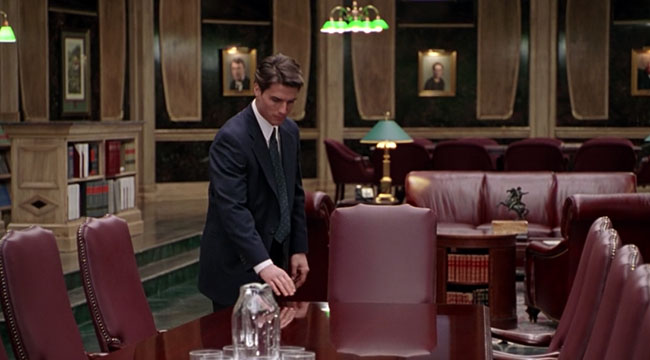
I'm amused that a PI in The Firm is a Lomax and then we have Kevin and Mary Ann Lomax in The Devil's Advocate and the James Tobias Lomas Inc. rental agency in Eyes Wide Shut. The story of Tobias concerns a man who is blinded, and whose vision is restored by the same fish that heals the situation of a woman who is plagued with the spirit of lust, it killing every one of her bridegrooms before the marriage can be consummated. The same story is repeated over and over of the bridegroom dying, but Tobit, Tobias' son, escapes that fate by means of properties of a fish that he had caught, that same fish restoring Tobias' sight--and certainly the story of Tobias, and Sarah, whose husbands all died, are linked for they were both contemplating suicide and both saved by the same fish.
Though the below image of James Tobias Lomas, Inc. is from the night Bill visits the pianist at the nightclub, we observe it again when Bill goes to the diner, a doctor playing PI, trying to find out where the pianist is staying, as he attempts to investigate the happenings at Somerton the previous night.
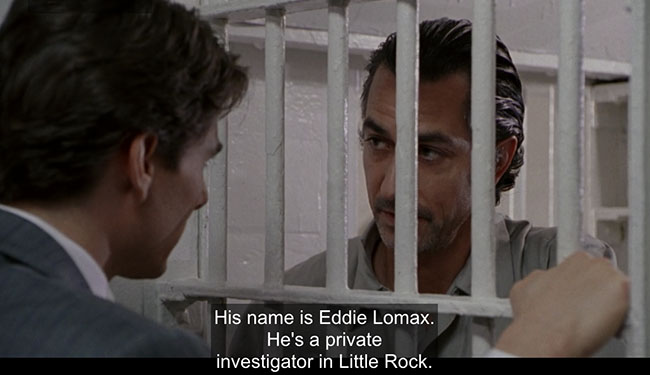
The labyrinthine streets that Bill walks in Eyes Wide Shut are very similar in tone to those in The Firm.
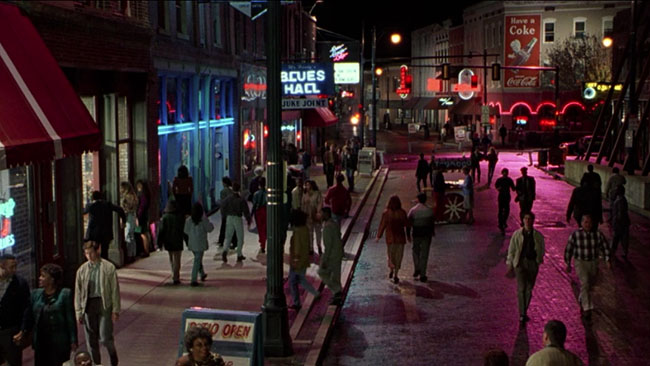
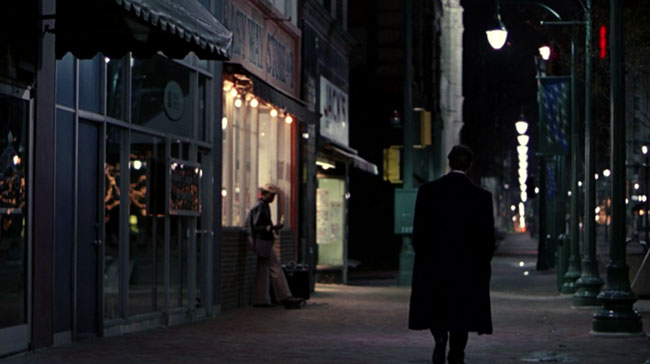
The streets are so similar that one might confuse the above image, from The Firm, as instead being from Eyes Wide Shut, as is the below image.
A bench is the scene where the Department of Justice surreptitiously meets with Mitch, near the "temple" of the Lincoln Memorial, giving him info they have on the firm, how they have killed lawyers who attempted to leave, and wanting his assistance in bringing the firm and the mob down. When he asks if his life is in danger he's informed that, "Your life as you know it is over". Bill, returning to his apartment, after his second trip to Somerton, which is when we see the man on the bench outside the second time, has been reminded that he and his family are in danger.
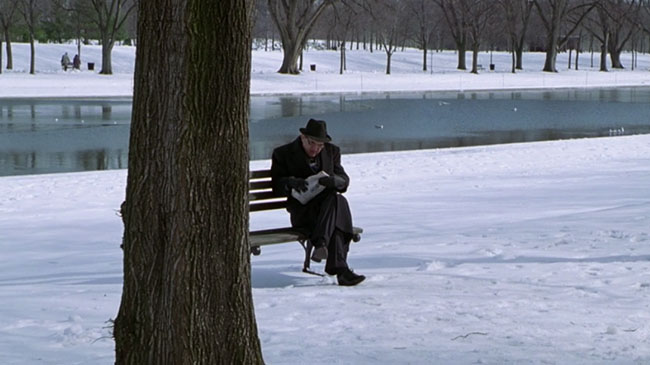

Mitch and his wife, in the process of gathering the information that will bring down the firm, also set up new lives for themselves, and, not trusting the feds, only implicate the firm, not the mob. Mitch informs the mob that as he is their lawyer he can't testify against them, his information on them will never be revealed, it lis like cargo on a boat that never reaches port. As long as he's alive the ship will always be at sea, much like the Flying Dutchman until Judgment Day. I only include this as Kubrick refers several times to the Judgment Day via Dies Irae and the Flying Dutchman, most notably in The Shining, though he revisits the Flying Dutchman theme in Eyes Wide Shut.
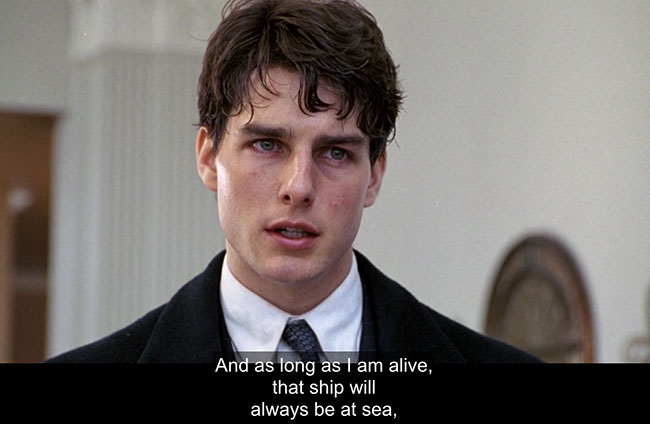
It has been said there are only a few stories to be told. Similarities could all be coincidental, but if not I look upon them as notations between the lines that expand upon the film.
The Devil's Advocate, The Firm, and Eyes Wide Shut are about marriage, faithfulness, infidelity, becoming seduced by power and discovering the dark side behind it.
The Devil's Advocate is also about child sexual abuse, which is often referred to in Kubrick's films, though with the exception of Lolita it's not a primary focus. In The Shining sexual abuse of a minor was referred to through The Summer of 42, a film based on a real life occurrence that traumatized the author and writer of the film's screenplay, but if one is not familiar with the film or book one won't know this. In the book, Barry Lyndon, Thackeray makes the reader very aware of the age gap between Barry and his first love, his cousin, that he was only a youth and his cousin was an adult, and that this profoundly affected his dealings with how he saw women the rest of his life, and Kubrick downplays this aspect though it's still somewhat suggested in the original betrayal of Barry Lyndon but a cousin who is more knowledgable than him on, at least, seduction. In Eyes Wide Shut Kubrick has the girl who is based on an underage Pierrette in the "Traumnovelle" book who appears to be prostituted by her father, and the make-up on her face is very like Barry Lyndon's in the scene where Bill discovers she had evidently been prostituted and he is himself invited to return. I can't find my copy of "Traumnovelle" right now (I fear I've lost it for good) but toward the beginning, the character of Fridolin (Bill) is remembering a girl, fifteen I think, who he came across, alone, on a beach boardwalk, was attracted to her, and thought of her as a missed opportunity. He was pondering this even while he became hypocritically irate with his wife for her tale, and felt betrayed by her. Kubrick chose to not put this in Eyes Wide Shut, perhaps worrying the character of Bill would be removed from the sympathy of the audience. Instead, if Kubrick does refer to The Devil's Advocate, sexual abuse of a minor could also be viewed as incorporated between the lines, Kevin's primary offense against his conscience being his defense of a pedophile despite his having realized he is guilty. Bill is also presented with a difficulty of conscience concerning the girl at Rainbow Fashions, and the fact he does not call the authorities. But then, as with everything that happens that night, Bill ends up empty-handed, he has no idea what really happened, and I do think, we should be less inclined to look at it as a "realistic" film than one that is allegorical, just as was the original book, and just as is The Devil's Advocate, in which we are given a glimpse of Milton's true face and it is that of Kevin's. What Kevin has been fighting all along has been his own conscience, his own vanity.
A final comparison. The Devil's Advocate was released 17 October 1997 and by December the sculptor Frederick Hart had brought suit against them for a bas-relief in the film that he believed was based on his "Ex Nihilo" at the Washington Cathedral, naked figures of men and women emerging out of the tumult that he intended to be a sacred sculpture representing that the "world was created by God and reflects the goodness of God's intention". The bas-relief in the film, which is indeed similar, was in Milton's home and later came alive, the figures eventually awaking and moving and beginning to engage in sexual acts, said by Hart to be expressly demonic and thus a denial of the theological intent of his work. The suit was settled in February 1998. I wonder if Frederick Hart would have bothered with his copyright claim if he hadn't been offended by a copy of his work (not a direct copy but I guess close enough) had not been used in what he must have considered a very blasphemous scene--one in which Milton tempts Kevin while also making clear his foibles that have brought him nothing but agony ultimately, and his denial that he was responsible for his actions, his free will. There is a similarity with part of the original music Kubrick had chosen for the orgy having to be changed because of protests against its use. It was said that Kubrick used it for its exoticism and didn't know what the passage was--but it's difficult to believe he didn't know what music used in his film would be and that it was from the Bhagavad Gita. "For the protection of the virtuous, for the destruction of the evil and for the firm establishment of Dharma (righteousness), I take birth and am incarnated on Earth, from age to age." From what I've read the text occurs when Krishna reveals himself as Brahman to the hero, Arjuna, who has recoiled from a war that Krishna says is destined by the actions of many, so Arjuna must act in a certain way because of this (which is destiny), and his dread of causing death is erroneous as death does not exist.
The online Ancient History Encyclopedia gives this description:
In discussing immortality, Krishna reveals himself as Brahman, the source of all existence and existence itself. Krishna’s revelation astounds Arjuna but he, like any mortal, cannot remain in that state of pure reality and must retreat back to the world of illusion and doubt he has come to accept as true. Even so, through Krishna’s further efforts, Arjuna comes to understand that the reality he has been responding to throughout his life has not been true reality but only shadows and illusion. He has always tried to respond to what he saw as “true” honorably but recognizes that his perception of truth and actual Truth are quite different.
Which sounds very like what Bill discusses with Alice at the film's end, when, professing themselves to be awake now, forever, they say they discuss not knowing whether their adventures are real or only a dream, but that no dream is ever just a dream.
What is true and what is Truth. The same question was several times posed in Lolita as the difference between what was real and what was true.
There is no residing in this exalted state of awareness, however, as a mortal, and so there is the inevitable retreat to illusion, though on a higher plain of awareness.
It seems likely Kubrick would have wanted to know what was being said in his film. And if Kubrick knew the text, It's hard to believe Kubrick wouldn't have anticipated controversy and having to eventually change the track. Though it seems absurd, one might even be caused to wonder if he anticipated that a change would have to be made, and if so that is again another connection with The Devil's Advocate. But it also, briefly, revealed, if intentional, what he might have conceived of as a Truth revealed during, for all intents and purposes, an initiation scene to which Bill is invited and from which he is also expelled. He does not belong. He can't belong. He confronts illusion in this orgy of masks, then later considers himself, and Alice, to have had their eyes opened, awakened, "forever", which is not the kind of response one would expect to Bill's adventure if taken at face value as some simple orgy--which it isn't, it is an allegory, a spiritual awakening is involved. The language used at the film's end reflects this.
Then Alice, who is afraid of "forever", pulls his head out of the clouds and back down to the sensual earth again.
I return to the opening image of Alice in the dressing room that may echo the one in The Devil's Advocate, when Christabelle beckons Kevin to really look at her and assumes the posture of Christ on the cross. Kubrick instead only has Alice slip off her dress, then cuts away to "Eyes Wide Shut", the man on the bench opposite the San Remo, across from Central Park, and then Bill in the dark, finishing dressing in an only seemingly identical dressing room, looking for his wallet by which he identifies himself, and identifies himself to everyone as the good and righteous doctor. But as Alice warns him, in the bathroom, he's not really looking at her, not really seeing her, he is instead focused on himself in the mirror. Nor does he really hear her when she asks if he gave the phone and pager numbers to Roz, for he says yes, that he put them on the fridge, but then when meeting the babysitter, Roz, must ask Alice her name.
Posted 10 Sept 2020. Approximately 9200 words or 55 single-spaced pages. A 70 minute read at 130 wpm.
Go to Table of Contents of the EWS analysis
Link to the main film page for all the analyses


